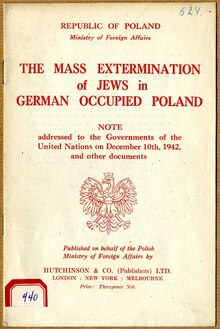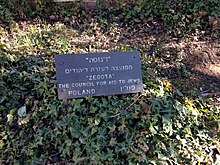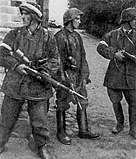This is an old revision of this page, as edited by François Robere (talk | contribs) at 23:00, 12 August 2018 (→Operational difficulties: See new comments under "survey"). The present address (URL) is a permanent link to this revision, which may differ significantly from the current revision.
Revision as of 23:00, 12 August 2018 by François Robere (talk | contribs) (→Operational difficulties: See new comments under "survey")(diff) ← Previous revision | Latest revision (diff) | Newer revision → (diff) For other uses, see Żegota (disambiguation). 3rd anniversary of Warsaw Ghetto Uprising: Żegota members, Warsaw, April 1946. Seated, from right: Piotr Gajewski, Ferdynand Marek Arczyński, Władysław Bartoszewski, Adolf Berman, Tadeusz Rek [pl]. 3rd anniversary of Warsaw Ghetto Uprising: Żegota members, Warsaw, April 1946. Seated, from right: Piotr Gajewski, Ferdynand Marek Arczyński, Władysław Bartoszewski, Adolf Berman, Tadeusz Rek [pl]. | |
| Predecessor | Provisional Committee to Aid Jews |
|---|---|
| Formation | September 27, 1942; 82 years ago (1942-09-27) |
| Founder | Henryk Woliński, |
| Type | Underground organization |
| Purpose | Help and distribution of relief funds to Polish Jews in World War II |
| Headquarters | Warsaw |
| Location | |
| Region | German occupied Poland |
| Key people | Henryk Woliński, Julian Grobelny, Ferdynand Arczyński, Zofia Kossak-Szczucka, Wanda Krahelska-Filipowicz, Adolf Berman, Leon Feiner, Władysław Bartoszewski |
Żegota (Template:IPA-pol, full codename: the "Konrad Żegota Committee") was the Polish Council to Aid Jews with the Government Delegation for Poland (Template:Lang-pl), an underground Polish resistance organization, and part of the Polish Underground State, active 1942–45 in German-occupied Poland. It was the successor to the Provisional Committee to Aid Jews.
Richard C. Lukas estimated that 60,000, or about half of the Jews who survived the Holocaust in occupied Poland (such estimates vary), were aided in some shape or form by Żegota. Czesław Łuczak estimates the number of aid recipients at about 30,000.
Operatives of Żegota worked in extreme circumstances - under threat of death by the Nazi forces, and often in the midst of a hostile population. Their work required exceptional bravery, and many were recognized as Righteous Among the Nations after the war.
Background and organization




The Council to Aid Jews, or Żegota, was the continuation of an earlier aid organization, the Provisional Committee to Aid Jews (Tymczasowy Komitet Pomocy Żydom), that was founded on 27 September 1942 by Polish Catholic activists Zofia Kossak-Szczucka and Wanda Krahelska-Filipowicz ("Alinka"). The Provisional Committee cared for as many as 180 people, but due to political and financial reasons it was dissolved and replaced by Żegota on December 4, 1942. Żegota was the brainchild of Henryk Woliński of the Home Army (AK).
Kossak-Szczucka initially wanted Żegota to become an example of a "pure Christian charity", arguing that Jews had their own international charity organizations. Nevertheless, Żegota was run by both Jews and non-Jews from a wide range of political movements. Julian Grobelny, an activist in the prewar Polish Socialist Party, was elected as General Secretary, and Ferdynand Arczyński - a member of the Polish Democratic Party - as treasurer. Adolf Berman and Leon Feiner represented the Jewish National Committee (an umbrella group representing the Zionist parties) and the Marxist General Jewish Labour Bund. Both parties operated independently, channeling funds donated by Jewish organizations abroad to Żegota and other underground operations. Other members included the Polish Socialist Party, the Democratic Party (Stronnictwo Demokratyczne) and the Catholic Front for the Rebirth of Poland (Front Odrodzenia Polski) led by Kossak-Szczucka and Witold Bieńkowski, editors of its underground publications. The right-wing National Party (Stronnictwo Narodowe) refused to take part in the organization.
Kossak-Szczucka went on to act in the Social Self-Help Organization (Społeczna Organizacja Samopomocy - SOS) as a liaison between Żegota and Catholic convents and orphanages as well as other public orphanages, which jointly hid many Jewish children.
Operations
Żegota had around one hundred cells that provided food, medical care, money, and false identification documents to some 4,000 Polish Jews hiding in the "Aryan" side of the German occupation zone. The organization was active chiefly in Warsaw, where it helped some 3,000 Jews who were in hiding, but it also provided money, food, and medicines for prisoners in several forced-labor camps, as well as to refugees in Kraków, Wilno (Vilnius), and Lwów (L'viv). Żegota's activities overlapped to a considerable extent with those of the other major organizations - the Jewish National Committee, which cared for some 5,600 Jews; and the Bund, which cared for an additional 1,500. Together, the three organizations were able to reach some 8,500 of the 28,000 Jews hiding in Warsaw, and perhaps another 1,000 hiding elsewhere in Poland.
Żegota was supported by the Home Army, which provided facilities for forging German identification papers. Żegota also forged about 50,000 other documents such as marriage certificates, baptismal records, death certificates and employment cards to help Jews pass off as Christians.
Żegota's children's section in Warsaw, headed by social worker Irena Sendler, cared for 2,500 of the 9,000 Jewish children smuggled out of the Warsaw Ghetto. Many were placed with foster families, in public orphanages, church orphanages, and convents. Żegota sometimes paid for the children's care. At war's end Sendler tried to return the children to their parents, but nearly all of the parents had died at Treblinka.
Żegota repeatedly asked the Polish Government-in-Exile and the Government Delegation for Poland to appeal to the Polish people to help the persecuted Jews. The Government in Exile gradually increased its funding for Żegota throughout the war.
Major incidents
Zofia Kossak-Szczucka was arrested in 1943 by a Gestapo unaware of the extent of her underground activities, transported to Auschwitz and liberated in 1944.
Operational difficulties
Under the German occupation, hiding or assisting Jewish refugees was punishable by death. According to Richard C. Lukas, "The number of Poles who perished at the hands of the Germans for aiding Jews" may have been as high as fifty thousand.
Financial difficulties
Martin Winstone concludes that "Żegota came too late to save most yet it proved indispensable in supporting thousands of Jews... faced a constant battle for funding, receiving more from Jewish organizations than from the government-in-exile, whilst the right-wing parties refused to support it."
Antony Polonsky writes that "Zegota's successes—it was able to forge false documents for some 50,000 persons—suggest that, had it been given a higher priority by the Delegatura and the government in London, it could have done much more." He quote Wladyslaw Bartoszewski saying that the organization was considered a "stepchild" of the underground; and Emanuel Ringelblum, who wrote that "a Council for Aid to the Jews was formed, consisting of people of good will, but its activity was limited by lack of funds and lack of help from the government."
Shmuel Krakowski writes that "Allocations of financial resources for Zegota’s activities were very modest. While no exact numbers are available, we can state that they did not exceed a quarter of a million dollars, including the sums from Jews abroad, which the Home Army couriers helped smuggle into occupied Poland. This was indeed very little considering not only the needs of the council and the immensity of the Jewish tragedy, but also the resources at the Polish underground’s disposal. The main Polish underground forces, those subordinated to the Delegatura, received funds during the war from the Western powers to cover their activities. This included about $35 million and 20 million German marks. Of course, they could have been much more generous in allocating resources needed to save human lives."
Joseph Kermish describes the relationship between Żegota and the Government Delegation as strenuous, with frequent disagreements about funding and the extent of the humanitarian crisis Żegota tried to address.
Prominent activists
In a letter from February 26, 1977 Adolf Berman mentions the following activists as especially meritorious:
- Maria Grzegorzewska
- Irena Solska
- Janina Buchholtz-Bukolska
- Irena Sawicka
- Ewa Rybicka
- Stanisław and Maria Ossowskie
- Jan and Antonina Żabińskie
- Stefania Sempołowska
- Jan Wesołowski [pl]
- Sylwia Rzeczycka
- Regina Fleszar [pl]
Postwar recognition

In 1963 Żegota was memorialised in Israel with the planting of a tree in the Avenue of the Righteous at Yad Vashem, with Władysław Bartoszewski present.
See also
- Rescue of Jews by Poles during the Holocaust
- History of the Jews in Poland
- Timeline of Jewish-Polish history
- Polish resistance movement in World War II
- Occupation of Poland (1939–45)
Notes and references
| Part of a series on the |
| Polish Underground State |
|---|
 History of Poland 1939–1945 History of Poland 1939–1945 |
| Authorities |
|
Political organizations Major parties Minor parties Opposition |
|
Military organizations Home Army (AK) Mostly integrated with Armed Resistance and Home Army Partially integrated with Armed Resistance and Home Army
Non-integrated but recognizing authority of Armed Resistance and Home Army Opposition |
| Related topics |
Specific
- Gunnar S. Paulsson (2002). Secret City: The Hidden Jews of Warsaw, 1940-1945. Yale University Press. p. 269. ISBN 978-0-300-09546-3.
- ^ Yad Vashem Shoa Resource Center, Zegota
- Władysław Bartoszewski: środowisko naturalne korzenie Michal Komar, Wladyslaw Bartoszewski Świat Ksia̜żki, page 238, 210
- "The Council to Aid Jews "Żegota" | Polscy Sprawiedliwi". sprawiedliwi.org.pl (POLIN Museum of the History of Polish Jews). Warsaw. Retrieved 2018-06-22.
The Council to Aid Jews, Żegota, was the only state-sponsored organization in occupied Europe which was set up with the aim of saving Jews.
{{cite web}}: Cite has empty unknown parameter:|dead-url=(help) - Golarz, Raymond J.; Golarz, Marion J. (2011-04-25). Sweet Land of Liberty. AuthorHouse. p. 95. ISBN 9781456746605.
This was the only organization in German-occupied countries established specifically to save Jews.
- Tadeusz Piotrowski (1997). "Assistance to Jews". Poland's Holocaust. McFarland & Company. p. 118. ISBN 0-7864-0371-3.
{{cite book}}: Cite has empty unknown parameter:|chapterurl=(help) - Bartrop, Paul R.; Dickerman, Michael (2017-09-15). The Holocaust: An Encyclopedia and Document Collection [4 volumes]. ABC-CLIO. p. 737. ISBN 9781440840845.
Poland was the only country in Nazi-occupied Europe where such an organization, run jointly by Jews and non-Jews from a wide range of political movements, existed
- ^ Robert Alvis (2016). White Eagle, Black Madonna: One Thousand Years of the Polish Catholic Tradition. Oxford University Press. pp. 212, 214. ISBN 0823271730.
- Andrzej Sławiński, Those who helped Polish Jews during WWII. Translated from Polish by Antoni Bohdanowicz. Article on the pages of the London Branch of the Polish Home Army Ex-Servicemen Association. Last accessed on March 14, 2008.
- Żydzi w Polsce: dzieje i kultura : leksykon Jerzy Tomaszewski, Andrzej Żbikowski Wydawnictwo Cyklady, 2001, page 552
- Encyclopedia of the Holocaust, volumes 3-4 Israel Gutman Macmillan Library Reference USA, page 1730
- Kirk, Heather (2004). A Drop of Rain. Dundurn. ISBN 9781894917100.
- Zagłada Drugiej Rzeczypospolitej: 1945-1947 - page 129 Aleksander Gella - 1998
- https://sprawiedliwi.org.pl/pl/aktualnosci/75-lat-temu-powstala-krakowska-zegota "Żegota" in Kraków Established 75 Years Ago Mateusz Szczepaniak / English translation: Andrew Rajcher, 14th March 2018 POLIN Museum of the History of Polish Jews
- Segel, Harold B. (1996). Stranger in Our Midst: Images of the Jew in Polish Literature. Cornell University Press. ISBN 080148104X.
- "Death Penalty for Aiding Jews — United States Holocaust Memorial Museum". www.ushmm.org. Retrieved 2018-06-01.
- Richard C. Lukas, Out of the Inferno: Poles Remember the Holocaust University Press of Kentucky, 1989; 201 pp.; p. 13; also in Richard C. Lukas, The Forgotten Holocaust: The Poles under German Occupation, 1939-1944, University Press of Kentucky, 1986; 300 pp.
- Winstone, Martin (2014). The Dark Heart of Hitler's Europe: Nazi rule in Poland under the General Government. London: Tauris. pp. 181–182. ISBN 978-1-78076-477-1.
- Holocaust: Responses to the persecution and mass murder of the Jews. Holocaust: critical concepts in historical studies. Vol. 5. book chapter by Antony Polonsky, edited by David Cesarani & Sarah Kavanaugh. London ; New York: Routledge. 2004. p. 64. ISBN 978-0-415-27509-5.
{{cite book}}: CS1 maint: others (link) - Contested memories: Poles and Jews during the Holocaust and its aftermath. Joshua D. Zimmerman (ed.), chapter by Shmuel Krakowski. New Brunswick, NJ: Rutgers University Press. 2003. p. 99. ISBN 978-0-8135-3158-8.
{{cite book}}: CS1 maint: others (link) - Kermish, Joseph. "The Activities of the Council for Aid to Jews ("Żegota") In Occupied Poland". www.yadvashem.org. Retrieved 2018-06-20.
- Jewish Resistance: Konrad Żegota Committee, Jewish Virtual Library
General
- Various authors. Andrzej Krzysztof Kunert, Andrzej Friszke (ed.). "Żegota" Rada Pomocy Żydom 1942–1945 (in Polish). Warsaw: Rada Ochrony Pamięci Walk i Męczeństwa. ISBN 83-916666-0-3.
{{cite book}}: Cite has empty unknown parameter:|chapterurl=(help) - Various authors (2003). Joshua D. Zimmerman (ed.). Contested Memories: Poles and Jews During the Holocaust and Its Aftermath. Rutgers University Press. p. 336. ISBN 0-8135-3158-6.
{{cite book}}: Cite has empty unknown parameter:|chapterurl=(help) - MS Nechama Tec (1986). When Light Pierced the Darkness: Christian Rescue of Jews in Nazi-occupied Poland. Oxford: Oxford University Press. ISBN 0-19-505194-7.
{{cite book}}: Cite has empty unknown parameter:|chapterurl=(help) - Tadeusz Piotrowski (1997). Poland's Holocaust. McFarland & Company. ISBN 0-7864-0371-3.
{{cite book}}: Cite has empty unknown parameter:|chapterurl=(help) - Gunnar S. Paulsson. Secret City: The Hidden Jews of Warsaw, 1940-1945. Yale: Yale University Press. p. 2002. ISBN 0-300-09546-5.
{{cite book}}: Cite has empty unknown parameter:|chapterurl=(help) - Irene Tomaszewski; Tecia Werbowski (1994). Zegota: The Rescue of Jews in Wartime Poland. Montreal: Price-Patterson.
{{cite book}}: Cite has empty unknown parameter:|chapterurl=(help) - Irene Tomaszewski; Tecia Werbowski (1994). Zegota: The Council to Aid Jews in Occupied Poland 1942-1945. Price-Patterson. ISBN 1-896881-15-7.
{{cite book}}: Cite has empty unknown parameter:|chapterurl=(help)
External links
- Excerpts from the book Żegota by Irena Tomaszewska & Tecia Werbowski
- Zegota - book and documentary film
- The Activities of the Council for Aid to Jews (“Żegota”) In Occupied Poland